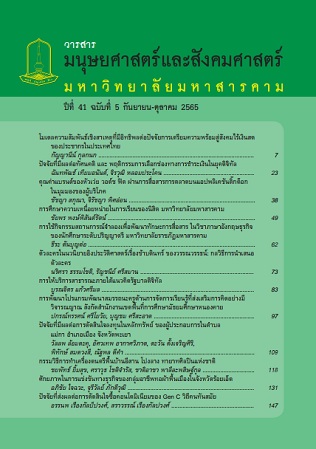The study of learning burnout of Mahasarakham university students
Main Article Content
Abstract
The purposes of this research were 1) to study the level of learning burnout of Mahasarakham University students and 2) to compare the learning burnout of Mahasarakham University students when classified by gender and faculty. The subjects for the study were 1,080 undergraduate students of Mahasarakham University who studied in the academic year 2020. The method for selecting the subjects was Stratified Random Sampling categorized by the group of faculties. The research instrument was an inventory for a measure of learning burnout. The statistical data used in analysis were mean, standard deviation, independent t - test and F - test.
From the research results:
- The learning burnout of undergraduate students was at a high level (
=3.70, S.D.=0.60).
- The learning burnout of undergraduate students when classified by gender, male and female undergraduate students had a statistically significant difference at the .05 level.
- The learning burnout of undergraduate students when classified by faculty group, undergraduate students from different faculties had significantly different at the .05 level.
Article Details
References
กานต์ชนก แซ่อุ่ย. (2554). ปัจจัยพยากรณ์ภาวะหมดไฟในการทำงานของผู้ให้การปรึกษาในเขตภาคเหนือตอนบน. จิตวิทยาคลินิก, 42(2): 19-31.
เด็กไทยเบื่อเรียนเซ็งครู. (2557). โพสต์ทูเดย์, 24 เมษายน: A6.
พัชรินทร์ เสรี. (2558). ปัญหาการเรียน. จิตเวช ศิริราช DSM-5. กรุงเทพฯ: คณะแพทย์ศาสตร์ศิริราชพยาบาล มหาวิทยาลัยมหิดล. 311-325.
วิฑูรย์ สิมะโชคดี. (2559). การเรียนศตวรรษที่ 21. โพสต์ทูเดย์, 16 มิถุนายน: B2.
สำนักงานคณะกรรมการพัฒนาการเศรษฐกิจและสังคมแห่งชาติ. (2560). ประมาณการผู้สำเร็จการศึกษาและเข้าสู่ตลาดแรงงาน จำแนกตามระดับการศึกษา พ.ศ. 2553-2561 สำนักงานคณะกรรมการพัฒนาการเศรษฐกิจและสังคมแห่งชาติ. สืบค้นเมื่อ วันที่ 13 พฤษภาคม 2560, ได้มาจาก https://www.m-society.go.th/news_view.php?nid=19451.
สำนักงานส่งเสริมวิสาหกิจขนาดกลางและขนาดย่อม. (2560). Burnout Syndrome เจาะกลยุทธ์การตลาด เติมไฟให้คนวัยทำงาน. สืบค้นเมื่อ วันที่ 11 มิถุนายน 2563, ได้มาจาก https://www.smeone.info/innovationdetail/8008?fbclid=IwAR1VkQJqrLVDDqEyQEz40okADsoIxdfZQNDTIIHmCj6mMQwf5OY4i1gp-4Q.
สำนักงานเลขาธิการสภาการศึกษา. (2553). แผนการศึกษาแห่งชาติ ฉบับปรับปรุง (พ.ศ. 2552-2559). กรุงเทพฯ: สำนักงานเลขาธิการสภาการศึกษา.
________. (2560). สมรรถนะการศึกษาไทยในเวทีสากล ปี 2559 (IMD 2016). กรุงเทพฯ: สำนักงานเลขาธิการสภาการศึกษา.
Asikainena, H., Salmela-Aroc, H., Parpalab, A., Katajavuoria, N. (2020). Learning Profiles and Their Relation to Study-Related Burnout and Academic Achievement among University Students. Learning and Individual Differences, 78: 1-7.
Eaves, J.L., Payne, N. (2019). Resilience, Stress and Burnout in Student Midwives. Nurse Education Today, 79: 188-193.
Heikkila, A. (2011). University Students’ Approaches to Learning, Self-Regulation, and Cognitive and Attributional Strategies: Connections with Well-Being and Academic Success [Academic Dissertation]. Helsinki: University of Helsinki.
Herrmann, J., Koeppen, K., Kessels, U. (2019). Do Girls Take School Too Seriously? Investigating Gender Differences in School Burnout from A Self-Worth Perspective. Learning and Individual Differences, 69: 150-161.
Heugten, K.V. (2011). Social Work under Pressure: How to Overcome Stress, Fatigue and Burnout in the Workplace. London and Philadelphia: Jessica Kingsley Publishers.
Ladstatter, F., Garrosa, E. (2008). Prediction of Burnout: An Artificial Neural Network Approach. Hamburg: Diplomica Verlag GmbH.
Lin, S., Huang, Y. (2014). Life Stress and Academic Burnout. Active Learning in Higher Education, 15(1): 77-90.
Ling, C., Lan, J., Zhu-hui, Y., Nan, L. (2013). A Survey on College English Learning Burnout. Sino-US English Teaching, 10(8): 608-614.
Maslach, C., Shaufeli, W.B., Leiter, M.P. (2001). Job Burnout. Annual Review of Psychology, 52: 397-422.
Pala, A. (2012). The Burnout Level among Faculty of Education Students at Celal Bayar University. Procedia-Social and Behavioral Sciences, 69: 1766-1774.
Palos, R., Maricutoiu, L.P., Costea, I. (2019). Relations between Academic Performance, Student Engagement and Student Burnout: A Cross-Lagged Analysis of a Two-Wave Study. Studies in Educational Evaluation, 60: 199-204.
Purvanova, R.K., Muros, J.P. (2010). Gender Differences in Burnout: A Meta-Analysis. Journal of Vocational Behavior, 77: 168-185.
Salmela-Aro, K., Kiuru, N., Nurmi, J. (2008). The Role of Educational Track in Adolescents' School Burnout: A Longitudinal Study. British Journal of Educational Psychology, 78: 663-689.
Salmela-Aro, K., Kiuru, N., Leskinen, E., Nurmi J. (2009). School-Burnout Inventory (SBI): Reliability and Validity. European Journal of Psychological Assessment, 25(1): 48-57.
Widlund, A., Tuominen, H., Tapola, A., Korhonen J. (2020). Gendered Pathways from Academic Performance, Motivational Beliefs, and School Burnout to Adolescents' Educational and Occupational Aspirations. Learning and Instruction, 66: 1-12.

